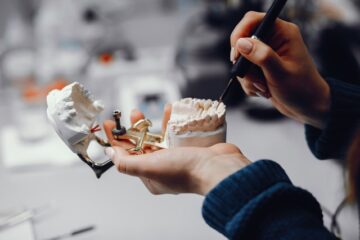What Are Retainers and How Do They Work?

Contents

The end of orthodontic treatment is typically marked by another notable event, the placement of dental retainers. They are vital to sustain the long-awaited result and protect your smile from potential misalignment. Your doctor may offer numerous retainer types, so it is beneficial to understand “what does retainers do” to conduct a comprehensive dialogue. How to keep teeth straight after braces, and how long do you need retainers? We’ve collected all relevant answers here!
What Is a Dental Retainer?
A retainer is an orthodontic appliance designed to maintain your teeth in their straightened position after treatment is complete. It reduces the risk of teeth returning to their natural position, reliably securing your smile makeover. Retainers are designed to fit tightly over or behind the teeth. The advancements in dental technology offer acrylic, clear plastic, or wires for retainers.
Modern retainers feature low visibility and enhanced comfort. You should wear them as indicated by your doctor to prolong your orthodontic results. Moreover, retainers support the jawbone as your teeth adjust to new positions.
Different Types of Retainers
Retainers are typically divided into two types: permanent and removable.
Removable Retainers
Removable retainers are manufactured of clear plastic and tailored to each patient’s needs. You can conveniently take them off during meals and tooth brushing. At other times, it’s vital to wear them as instructed to prevent relapse. Removable retainers demand extra attention, as they can warp because of heat and easily break if you accidentally drop them. They may also slightly impact your speech. In the case of malfunction, they can’t be fixed, meaning you’ll need a new pair each time a molded retainer cracks.
If you didn’t wear conventional metal braces but underwent functional Invisalign treatment, you might wonder whether to use the last pair of transparent plastic trays as retainers. It can work for some time, but it’s recommended to turn to specialized retainers after several months. Plastic in aligners is less rigid than in specifically designed retainers, meaning the trays can wobble over time.
Fixed (Permanent) Retainers
A permanent retainer is a customized piece of dental wire bonded to the inner side of the upper or lower six front teeth. Unlike the removable retainers, you can’t take them off; only your doctor can do it. Such retainers help teeth stay in place and not shift to their original positions. Since fixed retainers shield only front teeth, you’d better use them in combination with removable retainers. They require diligent daily cleaning to prevent plaque and tartar.
How to Choose the Best One?
The best way to decide on the most fitting type of retainer for you is to consult your lead orthodontist. A doctor is perfectly aware of your teeth’s peculiarities as they observe the migration of your pearly whites throughout the entire course of treatment. You might want to outline your preferences and lifestyle specifics to get expert advice.
Consider the following factors prior to choosing a retainer:
- Aesthetics. Clear retainers are almost invisible, meaning others aren’t likely to notice them. The wire in permanent retainers is also undetectable as it envelops the back side of your front teeth.
- Convenience. With permanent retainers, you need to follow a regular dental routine, while plastic retainers require extra cleaning.
- Efficiency. All types of retainers are effective if you adhere to maintenance recommendations and use them properly.
- Maintenance. Permanent retainers basically require routine oral hygiene. Caring for removable retainers should become part of your daily schedule so as not to forget to wear them as prescribed.
- Durability. Clear retainers usually last 6–12 months, while fixed retainers can last a lifetime with proper care. You have to try hard to cause the bonding material to fail, like chewing on ice, having a dental injury, or grinding your teeth. Bruxism may prevent you from getting removable retainers, as the alternative solutions appear more reasonable.
Don’t rush and examine each retainer type thoroughly, as this dental investment is meant to stay on your teeth for years. Ponder whether you are ready to commit extra time to proper maintenance and whether the retainer’s material is comfortable for you. If you struggle to define the most fitting kind of retainer for you, consult well-versed dental experts in Forest Hills, NY, or address a reputable local orthodontist at the place of your residence.
How Do Retainers Work?
Now that you know what are retainers for, it’s time to explore their working principle.
Once your teeth are straight, an orthodontist removes your braces and makes a mold of your teeth. It serves as the basis for designing your future retainer. As soon as the retainer is ready, it’s crucial to follow your doctor’s recommendations to prevent your teeth from moving. Once the bite is aligned, you should make an effort to use a retainer properly to sustain the result.
Why Wearing a Retainer After Braces Is Essential
Retainers are essential to preserve your renewed smile functionality and aesthetics. They help secure the outcomes of lasting orthodontic treatment and support long-term oral health. When your teeth are straightened with braces, they might need up to 6 months to adjust to their new position. During this time, you risk having your teeth shifted back to their original site if you neglect a retainer. This is what are retainers used for in orthodontic practice.
How to Clean and Care for Your Retainer
If you are interested in preserving the results of your orthodontic treatment for years, you should understand how to use retainers and care for them properly.
- Permanent retainers
Thorough oral hygiene is essential to prevent dental plaque from accumulating around permanent retainers. It might be troublesome to get into the nooks around a retainer, which induces the need for regular professional teeth cleaning at a dental office.
- Removable retainers
You need to clean the retainers regularly to remove tartar accumulation. To make cleaning easier and more effective, you can soak the clear trays when you’re not wearing them. Gently brush your retainers with toothpaste or a specialized cleaner for dentures each time you brush your teeth.
A dirty retainer is a favorable environment for bacteria, so it needs daily attention to prevent build-up. Remember to use only cold or lukewarm water, as hot temperatures can cause damage. Removable retainers should be kept in a protective case so that they remain clean and you don’t lose or break them.
When you feel plastic retainers don’t fit tightly anymore, schedule an appointment with your orthodontist and consult them on the issue. You might need to replace a worn-out retainer with a new one.
How Long Do Retainers Last? When to Replace Them
There’s no uniform retainer’s lifespan as it depends on the material used, the quality of maintenance, and how your teeth adjust to their final position. Here is the approximate durability for a better orientation:
- Fixed retainers can last a lifetime with diligent care and attentive maintenance. You might need to replace a retainer if you accidentally damage it by eating very hard, crunchy, or sticky foods or during contact sports activities.
- Removable retainers can endure 6–12 months before the plastic fits not so snugly on your teeth. They might need yearly replacement and new impressions if your teeth change shape, like with substantial dental restorations or porcelain veneers.
Retainers are indispensable to keep your teeth from moving after you have them straightened with braces or clear aligners. Do retainers move teeth? — No, they secure the new positions of your pearly whites, ensuring their permanence. When browsing the guidelines on proper retainer care, prioritize your doctor’s recommendations. Collaborate with your orthodontist to get all-encompassing instructions tailored to your unique case.
Frequently Asked Questions About Dental Retainers
Do I need to wear my retainer forever?
Fixed retainers will stay on your teeth until you occasionally damage them, but wearing them isn’t bothersome. Just brush and floss them as your teeth and visit a reputable dental office for regular professional cleaning.
Removable retainers usually need persistent wear for 3–6 months after a doctor removes your braces. After your teeth stabilize, you can wear them only at night. Always stick to the instructions of your dental care provider to avoid potential complications caused by improper retainer use.
Can I get retainers instead of braces?
Retainers only fix the position of your teeth; they don’t move them. Thus, getting retainers instead of braces would be a waste of time and money.
Do retainers hurt more than braces?
After the placement of retainers, you may have a slight pulling or tensioning feeling, which seems rather unusual than painful. Your teeth will eventually get used to it, and you won’t likely experience any discomfort at all.
Additional Resources
- In this critical review, you may see what orthodontic retainers look like and learn more details about their application.
The results of expert comparison of fixed versus removable orthodontic retainers may ease your decision-making process.













